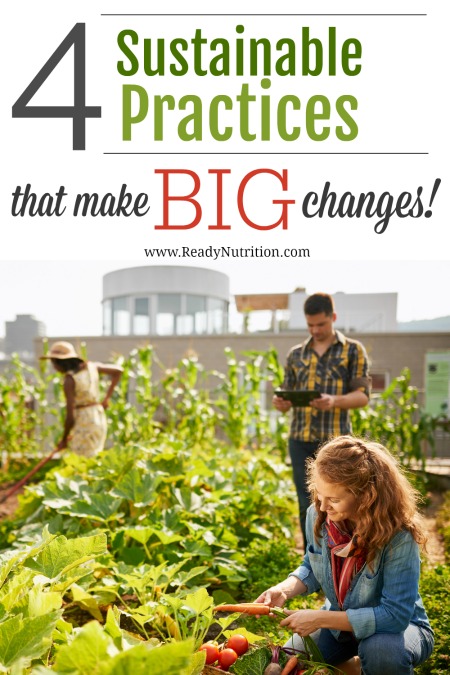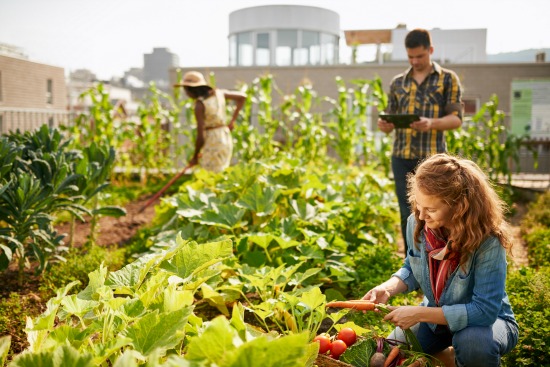Whether we are climate change activists or skeptics, we can all agree that we should all be doing our part to leave our Earth in the best condition possible. Sustainability isn’t always the easiest thing to accomplish considering our consumerist lifestyle in the U.S., but we’ve come up with four things that can really have an impressive impact and make big changes!
-
COMPOSTING
Composting allows you to literally turn your trash into treasure! It may be tough to make the decision and get started, but it’s worth it! Your garden will also thank you (see #2). Soil is one of the most important ingredients you need for a productive garden. In order to have a lush garden that grows big, juicy vegetables, you need lots of nutrients in the soil. And this is where composting comes in. Compost doesn’t replace your soil but instead acts as a natural fertilizer for it, making it worth the planning and effort!
The first thing you will want to figure out is the location of your bin. Placing the bin adjacent to or actually in your garden will save some time and labor when it’s time to apply your finished product. One cubic yard of compost can weigh up to a ton! Make sure you put the compost pile on the actual soil as well! You’ll want the bugs and earthworms to work their way into the composting material. If you put the compost pile on a concrete pad, it’ll be much more difficult because the compost will be cut off from the ecosystem.
Begin by adding equal parts of “brown” waste and “green” waste to your compost bin. “Green” waste includes fruits and vegetables and “brown” waste can be items like wood shavings, dry leaves, or even old newspapers. Maintaining a balance between the two is important is because “brown” materials are rich in carbon, feeding the organisms that break down the scraps and “green” materials supply nitrogen, which is the key for building the cell structure of your new soil. Keep in mind your compost will also need to “breathe”. It will need oxygen and some air flow to break down the waste into usable compost. –Ready Nutriton
Follow our quick composting guide here
Once the compost looks like soil, it is ready to use! Work it into your garden beds, or sprinkle it on top of your garden! Your garden will thrive! Speaking of gardening…
2. GROW A GARDEN
America was founded upon an agrarian lifestyle, and farmers were the driving force behind America. Currently, people are trying to find ways to move back to farming in order to grow their own food, be more self-sufficient, and less dependent on the highly-unstable government. In fact, by growing your own food, you cut down on trips to the grocery, thus cutting down on gasoline, carbon emissions and save some money in the process. All around, it’s a wonderful adventure.
Not only do you get to enjoy the delicious vegetables you grow, but taking care of a garden keeps you in shape! With nearly 75% of men and more than 60% of women who are obese or overweight, it’s important to consider our health in the sustainability equation too. The burden obesity is putting on our already strained healthcare system is not sustainable, and these little changes could end up being big ones in the end! Not only will your garden produce healthy options, weeding it and doing the work to maintain it will help keep you fit.
3.REUSE YOUR TRASH
When we started our garden this year, we planted organic heirloom seeds indoors because we live in a colder climate. Starting them in February in a small town also meant planters weren’t available, so we used what we had – empty bean cans, plastic containers, and empty aluminum cans were our go-to. And, as an added benefit, all of these things can still be recycled after you transplant your seedlings! My husband simply drilled holes in the bottom of the trash (obviously glass wasn’t an option) and we planted away! All of those “pots” saved us a bunch of money, did double duty, and have already been recycled.
Here are some other ways you can re-purpose your trash and have zero waste in your kitchen:
- Re-use produce bags
- Make homemade fire starters for outdoor fires
- Homemade paper pots for gardening
- 20 Ways to Use Up Bacon Grease
- Reuse wine corks
Another trick for those clothes your kids ruin beyond repair or stain so bad a thrift store won’t even take them is to make them into rags or reusable shopping bags.
Get inventive with your trash, especially if you’re on a budget! Your wallet and the Earth will thank you!
4. CONSERVE WATER
Did you know that if a household started conserving water, you can reduce your in-home water use by 35%? This means the average household, which uses 130,000 gallons per year, could save 44,000 gallons of water per year. Learning ways to practice the art of conserving water now, will help you make the most of your water sources.
A small drip from a worn faucet washer can waste 20 gallons of water per day. Larger leaks can waste hundreds of gallons. Check for leaks in hoses as well as this also wastes large amounts of water.
Another simple way to cut down on water use is to turn off the shower after soaping up, then turn it back on to rinse. A four-minute shower uses approximately 20 to 40 gallons of water!
With these simple sustainable changes, you could make a big impact on the Earth and on your bank account! What are your ideas for reusing trash or conserving water? Let us know in the comments!

This article was originally published at Ready Nutrition™ on July 15th, 2019








Someone just revealed to me that they’ve been having great luck flattening cardboard boxes down to suppress weeds. It’s also biodegradable. I’m going to give that a shot, and see how it works.
Old, really trashed clothing makes great cleaning rags, quilting material, rag rugs, etc.
If you need a large utility bucket, ask at a local laundromat that has a drop and run service. Commercial laundry soap comes in 4 1/2 gallon buckets with lids and the laundry may have empty buckets available for free or a nominal charge.
Yard sales often put leftover items out for free after the sale.
I try to reuse everything I can or at least recycle it properly. I try to toss food onto the property that can feed some of the animals and any paper or cardboard that is being disposed of is cut up and put in the bin before it gets wet, dirty or otherwise unfit for recycling. The steel and aluminum cans I store and make a trip with a full car to the scrap yard. I’d like to get into the habit of taking reuse-able shopping bags to stores, but haven’t gotten there yet. In order to reduce my water use, I always use a towel or sponge to clean things rather than waste water trying to wash an item with a heavy flow. A slow flowing faucet cleans just as well.
what about meat that has spoiled or has been cooked but not eaten in a few days..what do I do with that?
Well, why did your meat spoil? If you aren’t going to use it, cook it with salt and preserve in a jar in some lard or tallow (fat) – you can find how to do this online and it is super simple. I made some in early April with some filets that needed to be cooked but it wasn’t going to happen. I just ate some today – so good.
As to cooked not eaten again take the next step of preserving or repurpose in another dish e.g a piece of chicken and a piece of beef leftover, combine to make a fried rice dish.
Make any old meat products go to good use and breed magots. Great for fishing as I do.